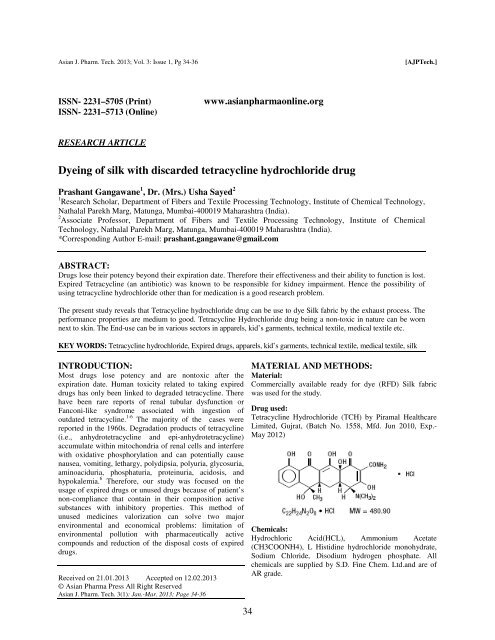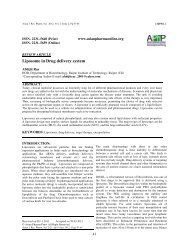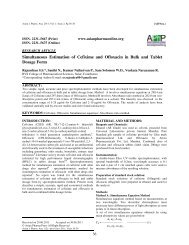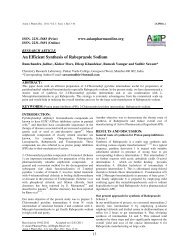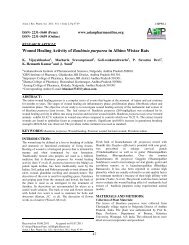Download PDF - asian pharma press
Download PDF - asian pharma press
Download PDF - asian pharma press
Create successful ePaper yourself
Turn your PDF publications into a flip-book with our unique Google optimized e-Paper software.
Asian J. Pharm. Tech. 2013; Vol. 3: Issue 1, Pg 34-36<br />
[AJPTech.]<br />
ISSN- 2231–5705 (Print)<br />
ISSN- 2231–5713 (Online)<br />
www.<strong>asian</strong><strong>pharma</strong>online.org<br />
RESEARCH ARTICLE<br />
Dyeing of silk with discarded tetracycline hydrochloride drug<br />
Prashant Gangawane 1 , Dr. (Mrs.) Usha Sayed 2<br />
1 Research Scholar, Department of Fibers and Textile Processing Technology, Institute of Chemical Technology,<br />
Nathalal Parekh Marg, Matunga, Mumbai-400019 Maharashtra (India).<br />
2 Associate Professor, Department of Fibers and Textile Processing Technology, Institute of Chemical<br />
Technology, Nathalal Parekh Marg, Matunga, Mumbai-400019 Maharashtra (India).<br />
*Corresponding Author E-mail: prashant.gangawane@gmail.com<br />
ABSTRACT:<br />
Drugs lose their potency beyond their expiration date. Therefore their effectiveness and their ability to function is lost.<br />
Expired Tetracycline (an antibiotic) was known to be responsible for kidney impairment. Hence the possibility of<br />
using tetracycline hydrochloride other than for medication is a good research problem.<br />
The present study reveals that Tetracycline hydrochloride drug can be use to dye Silk fabric by the exhaust process. The<br />
performance properties are medium to good. Tetracycline Hydrochloride drug being a non-toxic in nature can be worn<br />
next to skin. The End-use can be in various sectors in apparels, kid’s garments, technical textile, medical textile etc.<br />
KEY WORDS: Tetracycline hydrochloride, Expired drugs, apparels, kid’s garments, technical textile, medical textile, silk<br />
INTRODUCTION:<br />
Most drugs lose potency and are nontoxic after the<br />
expiration date. Human toxicity related to taking expired<br />
drugs has only been linked to degraded tetracycline. There<br />
have been rare reports of renal tubular dysfunction or<br />
Fanconi-like syndrome associated with ingestion of<br />
outdated tetracycline. 1-6 The majority of the cases were<br />
reported in the 1960s. Degradation products of tetracycline<br />
(i.e., anhydrotetracycline and epi-anhydrotetracycline)<br />
accumulate within mitochondria of renal cells and interfere<br />
with oxidative phosphorylation and can potentially cause<br />
nausea, vomiting, lethargy, polydipsia, polyuria, glycosuria,<br />
aminoaciduria, phosphaturia, proteinuria, acidosis, and<br />
hypokalemia. 6 Therefore, our study was focused on the<br />
usage of expired drugs or unused drugs because of patient’s<br />
non-compliance that contain in their composition active<br />
substances with inhibitory properties. This method of<br />
unused medicines valorization can solve two major<br />
environmental and economical problems: limitation of<br />
environmental pollution with <strong>pharma</strong>ceutically active<br />
compounds and reduction of the disposal costs of expired<br />
drugs.<br />
Received on 21.01.2013 Accepted on 12.02.2013<br />
© Asian Pharma Press All Right Reserved<br />
Asian J. Pharm. Tech. 3(1): Jan.-Mar. 2013; Page 34-36<br />
MATERIAL AND METHODS:<br />
Material:<br />
Commercially available ready for dye (RFD) Silk fabric<br />
was used for the study.<br />
Drug used:<br />
Tetracycline Hydrochloride (TCH) by Piramal Healthcare<br />
Limited, Gujrat, (Batch No. 1558, Mfd. Jun 2010, Exp.-<br />
May 2012)<br />
Chemicals:<br />
Hydrochloric Acid(HCL), Ammonium Acetate<br />
(CH3COONH4), L Histidine hydrochloride monohydrate,<br />
Sodium Chloride, Disodium hydrogen phosphate. All<br />
chemicals are supplied by S.D. Fine Chem. Ltd.and are of<br />
AR grade.<br />
34
Asian J. Pharm. Tech. 2013; Vol. 3: Issue 1, Pg 34-36<br />
Methods:<br />
Dyeing of Silk<br />
1% stock solution of Tetracycline Hydrochloride was<br />
prepared for dyeing. Silk was dyed with Tetracycline<br />
hydrochloride keeping liquor ratio of 20:1, at 100 0 C for 60<br />
min. Then rinsed and dried.<br />
Colour Measurement.<br />
Dyed samples were evaluated for the depth of the colour by<br />
determining K/S values using a Spectraflash® SF 300,<br />
Computer Colour Matching System supplied by Data color<br />
International, U.S.A. An average of four readings taken at<br />
four different sample areas, was used to calculate the<br />
reflectance values, and Kubelka Munk K/S function which<br />
is given by:<br />
K ( 1 - R ) 2<br />
=<br />
S 2 R<br />
Where,<br />
"R" is the reflectance at complete opacity.<br />
"K" is the absorption coefficient.<br />
"S" is the scattering coefficient.<br />
[AJPTech.]<br />
RESULTS AND DISCUSSION:<br />
Drugs lose their potency beyond their expiration date, and<br />
therefore their effectiveness and their ability to dissolve can<br />
be affected. For patients who rely on medications to stay<br />
alive, like heart medications, expired drugs can be<br />
dangerous because they may not be getting the full<br />
effectiveness of the drug. It depends on the medication.<br />
Expired Tetracycline (an antibiotic) was known to be<br />
responsible for kidney impairment.<br />
In this work an approach which was an innovative method<br />
was experimented where Tetracycline Hydrochloride were<br />
used to apply on the protein fiber namely Silk.<br />
The dyeing of Silk was carried out at 100 o C for 60 min and<br />
the concentration was varied between 0.5% to 3% and the<br />
results are shown in Table 1 and Figure 1, 2 and 3and 4.<br />
Tone of the Colour is also measured on the same machine<br />
Tone of the Colour in terms of CIE L*a* and b* values.<br />
Washing Fastness was carried out by ISO 105-CO1.<br />
Light Fastness was carried out by ISO 105-B02.<br />
Rubbing Fastness was carried out by ISO 105-X12.<br />
Perspiration Fastness was carried out by ISO 105 – E04.<br />
0.5%TCH 1%TCH 2%TCH 3% TCH<br />
Figure 1 : Shade Card of Dyeing of Silk with Tetracycline<br />
Hydrochloride at various Concentration<br />
Table 1 : Colorant strength calculation values of Silk substrate dyed with TCH dissolved in dilute Hydrochloric acid at varies<br />
concentration .<br />
Sr No. TCH Conc.% L* a* b* C* H* Colour Strength (%) K/S<br />
1 0.5 74.03 0.412 32.604 32.607 89.24 100 1.5396<br />
2 1 76.287 -0.032 36.105 36.105 90.087 201.021 3.0949<br />
3 2 74.946 1.495 35.663 35.694 87.564 441.194 6.7926<br />
4 3 72.94 2.419 33.221 33.309 85.801 592.212 9.1176<br />
Table 2: Fastness properties of Silk substrate dyed with TCH drug dissolve in carious dilute Acids<br />
Sr.No. TCH Washing Light Rubbing Fastness<br />
Fastness to perspiration<br />
%Shade Fastness Fastness Dry Wet Alkaline Acidic<br />
1 0.5% 3-4 6 5 4-5 3-4 3-4<br />
2 1% 3-4 6 5 4-5 3-4 3-4<br />
3 2% 3-4 6 5 4-5 3-4 3-4<br />
4 3% 3-4 6 5 4-5 3-4 3-4<br />
Figure 2: Colour Strength (%) Vs Concentration of Tetracycline Hydrochloride in %<br />
35
Asian J. Pharm. Tech. 2013; Vol. 3: Issue 1, Pg 34-36<br />
[AJPTech.]<br />
Figure 3 : K/S Vs Concentration of Tetracycline Hydrochloride in %<br />
The drug is yellow in color with the brown cast powder,<br />
acidic in nature and freely soluble in dilute Hydrochloric<br />
acids. It has been found that Silk fabric dyed with<br />
Tetracycline Hydrochloride and exhibits a wide gamut of<br />
colour shade. Also shows uniformity and levelness. Table 1<br />
indicates that the L value increases from 0.5% to 1% and<br />
fabric become slightly lighter but then after L value found<br />
to be decreasing from 1% to 3% hence as the concentration<br />
of Tetracycline Hydrochloride increases the darkness<br />
increases. The value of a*found to be decreasing as the<br />
concentration of Tetracycline Hydrochloride increases<br />
from 0.5% to 1% therefore the fabric shade shows slightly<br />
increase in greenness but then after the value of a increasing<br />
and become maximum at 3%. Hence it can be observe from<br />
figure 1 that as the concentration increases the Redness<br />
characteristics increases from 1% to 3% . The fabric shows<br />
maximum redness at 3%. The value of b* increased from<br />
0.5% to 1% and become maximum 1% which indicate that<br />
yellowness increases and become maximum at 1% but then<br />
after value of b* slightly decrease as increase in %shade<br />
hence blueness characteristic increases in shade. At 3%<br />
shade Silk fabric become maximum Redder as compare to<br />
all other shades. From the table 1 it has been observed that<br />
the Colour Strength increases and maximum at 3%. The<br />
K/S values also increases with the increase in concentration.<br />
Thus Tetracycline Hydrochloride drug can be used to dye<br />
Silk fabric by the exhaust process. TCH ionizes into<br />
chloride groups and hence can easily form ionic bonds with<br />
the cationic amino groups of Silk. And therefore as seen in<br />
table 1 and figure 1 with increase in concentration of<br />
tetracycline hydrochloride, the colour strength increases and<br />
K/S values was also increases. Since in the acidic pH the<br />
protonation of Silk increases and hence the increase ionic<br />
concentration of the drug is able to capture more sites and<br />
form bonds resulting in higher uptake. The mechanism is<br />
very similar to that of an acid dye used for dyeing of Silk.<br />
The wash fastness , the light fastness, the rubbing fastness<br />
as well as the perspiration fastness as seen in table 2 are<br />
good , indicating ionic bond linkage which are faster to<br />
light, wash and perspiration with increase in % shade there<br />
is increase in fastness properties. The figure 1,2,3 and 4<br />
36<br />
again indicate the above mechanism. The successful dyeing<br />
of Silk by using a drug which has expired potency for<br />
human consumption can be recycled to dye the Silk fabric<br />
instead of polluting the effluent and the whole process is<br />
environmental friendly and a very good alternative for the<br />
use of the expired tetracycline hydrochloride drug.<br />
CONCLUSION:<br />
The above experimentation has exhibited the uniform level<br />
dyeing of Silk possessing antimicrobial properties can be<br />
achieved by using expired TCH as an acid dye for dyeing of<br />
Silk with a wide gamut of colours with increasing<br />
concentration. Such an innovative experimentation on<br />
expired drug has been studied for the first time in the<br />
Textile processing.<br />
ACKNOWLEDGEMENTS:<br />
The authors are thankful to the Department of Fibers and<br />
Textile Processing Technology, Institute of Chemical<br />
Technology, Matunga, Mumbai for providing<br />
infrastructural facilities and University Grant Commission<br />
(UGC) for providing financial support for this research<br />
work.<br />
REFERENCES:<br />
1. Gross JM. Fanconi Syndrome (adult type)developing secondary<br />
to the ingestion of outdated tetracycline. Ann Intern Med<br />
1963;58:523-8.<br />
2. Frimpter GW, Timpanelli AE, Eisenmenger WJ, etal. Reversible<br />
“Fanconi Syndrome” caused by degraded tetracycline. JAMA<br />
1963:184;111-3.<br />
3. Montoliu J, Carrera M, Darnell A, Revert L. Lactic acidosis and<br />
Fanconi’s syndrome due to degraded tetracycline. Br Med J (Clin<br />
Res Ed)1981;283:1576-7.<br />
4. Fulop M, Drakin A. Potassium-depletion syndrome secondary to<br />
nephropathy apparently caused by “outdated tetracycline.” New<br />
Engl J Med 1965;272:986-9.<br />
5. Wegienka LC, Weller JM. Renal tubular acidosis caused by<br />
degraded tetracycline. Arch Intern Med 1964;114:232-5.<br />
6. Hemstreet BA. Antimicrobial-associated renal tubular acidosis.<br />
Ann Pharmacother 2004;38:1031-8.


